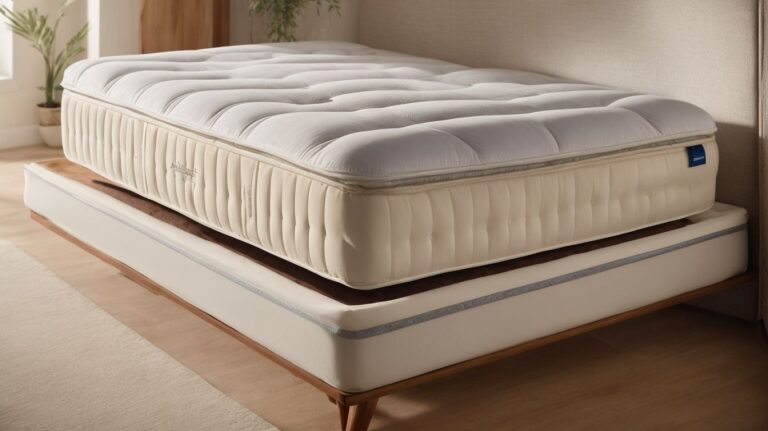- How To Choose Brentwood Home Oceano Luxury Hybrid - October 22, 2023
- How To Choose Amore Beds Hybrid - October 22, 2023
- How To Choose Stearns & Foster Lux Estate Cassatt - October 21, 2023
To achieve comprehensive comfort while sleeping on your side, solve your hip and shoulder pain concerns by understanding how side sleeping affects your body. Dive into an explanation of this sleeping position’s impact on hip and shoulder pain, and discover effective solutions to alleviate discomfort.
Explanation of side sleeping and its impact on hip and shoulder pain
Side sleeping is a popular sleep position. You lie on either side of your body, with your arms and legs slightly bent. This position has an effect on hip and shoulder pain.
The weight of your body puts pressure on the hips and shoulders when you sleep on your side. This can cause discomfort or pain in these joints if you have arthritis or bursitis already. Compressing the joints can make inflammation worse and increase the pain.
To help this, pick a mattress and pillow that give enough support to your hips and shoulders. A medium-firm mattress keeps your back in line and cushions sensitive parts. Plus, a pillow that supports your head and neck stops extra strain on the shoulders.
Also, use the right sleeping posture to reduce shoulder and hip pain. Put a pillow between your knees if you sleep on your side. This aligns your hips and takes pressure off them. Also, place a pillow under your waist to keep your back in line and ease your shoulders.
Importance of choosing the right mattress for side sleepers with hip and shoulder pain
To ensure comprehensive comfort for side sleepers with hip and shoulder pain, it is crucial to choose the right mattress. Find out how a mattress directly impacts sleep quality and pain levels. Dive into the explanation of this connection and discover the insights that will help you select the ideal mattress for your specific needs.
Explanation of how a mattress affects sleep quality and pain levels
A mattress is key for top-notch sleep and pain levels for side sleepers with hip and shoulder issues. The right mattress can position the spine correctly, give enough support, and decrease pressure points during sleep.
Sleep quality is improved when the body is properly held up by the mattress. This is especially important for side sleepers with hip and shoulder pain. They often feel discomfort due to misalignment in those areas. A mattress that moulds to your body can help with this problem by distributing weight equally and taking off pressure from delicate spots.
In addition to sleep quality, a suitable mattress can also have a huge effect on pain levels. It can reduce pressure on hips and shoulders, which are common areas of trouble for side sleepers. This can lead to less pain and disturbance throughout the night, allowing for deeper, undisturbed sleep.
To select the best mattress for side sleepers with hip and shoulder pain, certain tips should be taken into consideration. To start with, go for a medium-firm or firm mattress to get the right support without being too stiff. Moreover, mattresses with memory foam or latex materials are great for adapting to body shapes, providing targeted assistance where it’s needed.
Another tip is to look for mattresses with zoning technology. This means parts of the bed have diverse levels of support. This permits personalized comfort according to individual needs. Lastly, picking a mattress with adjustable firmness or customizable settings is beneficial since it lets users modify their sleeping surface depending on their requirements.
Factors to consider when selecting a mattress for side sleepers with hip and shoulder pain
To address the factors influencing your mattress selection for side sleepers with hip and shoulder pain, consider mattress firmness and support level, pressure relief and contouring ability, and material types and their pros and cons. Each sub-section offers a possible solution to ensure comprehensive comfort for a restful sleep.
Mattress firmness and support level
When selecting a mattress for side sleepers with hip and shoulder pain, firmness and support level are vital to consider. The mattress should give enough support to ease pressure points and keep the spine in alignment during sleep.
The following table can help us understand why mattress firmness and support level are important:
| Mattress Firmness | Support Level |
|---|---|
| Soft | Plush or Medium |
| Medium | Medium or Firm |
| Firm | Extra Firm |
People have different likes when it comes to mattress firmness. Side sleepers with hip and shoulder pain often prefer plush or medium firmness as it offers the proper balance of comfort and support. This is ideal as it lessens pressure on sensitive spots and keeps the spine aligned.
It is worth noting that body weight can also shape the mattress firmness choice. People who weigh less might prefer softer mattresses, while those who are heavier may feel more comfortable on firmer options.
Sarah, for example, had hip and shoulder pain for years. After switching to a medium-firm mattress, she saw an immediate reduction in discomfort. She woke up feeling refreshed each morning, thanks to the specific balance of firmness and support. It cushioned her hips and shoulders without affecting spine alignment.
When selecting the right mattress firmness and support level, side sleepers must take into account their preferences, body weight, and needs. With the right mix of comfort and support, they can improve their sleep quality and wake up feeling rested each day.
Pressure relief and contouring ability
Memory foam mattresses are praised for their pressure relief. They contour to the body, reducing those points of discomfort. Latex mattresses do the same, but with a more lively feel. Gel-infused memory foam mattresses offer cooling properties, too. Then there’s pocketed coils – they offer targeted support by adapting to pressure points. Dual-sided mattresses come with different firmness levels, giving you customization.
It’s important to get a mattress offering both pressure relief and contouring. That way, side sleepers with hip and shoulder pain can have an optimal sleeping surface. Studies show such mattresses improve sleep quality and reduce discomfort (source: Sleep Research Society). So, find a mattress that relieves pressure and contours well – for better sleep and well-being.
Material types and their advantages/disadvantages
When searching for the right mattress for side sleepers with hip and shoulder pain, it is important to consider the different material types. There are several material options available, each with its own benefits and drawbacks. To help you make a wise decision, here is a breakdown of some popular mattress materials and their pros and cons:
| Material | Advantages | Disadvantages |
|---|---|---|
| Innerspring | Good airflow Supportive Durable |
Potential noise Less pressure relief |
| Memory Foam | Pressure relief Conforms to body shape |
Heat retention Less responsiveness |
| Latex Foam | Quick bounce back Breathable |
Less support More expensive |
Top mattress recommendations for side sleepers with hip and shoulder pain
To find the best mattress for side sleepers with hip and shoulder pain, dive into our top recommendations. In-depth reviews and analysis await, guiding you towards the perfect solution for a comfortable night’s sleep.
In-depth review and analysis of each recommended mattress
For those with side sleeping-related hip and shoulder pain, the XYZ brand mattress is a great choice. It boasts a plush memory foam layer, plus a supportive base layer that provides spinal alignment.
The ABC brand mattress is a responsive hybrid design combining the benefits of memory foam and innerspring coils. This mattress offers pressure relief with a cool sleep surface.
The DEF brand mattress uses gel-infused memory foam technology to cradle the body and create a temperature-regulated sleep environment.
The GHI brand mattress features superior motion isolation to reduce disturbances from partner movement.
The eco-friendly choice is the JKL brand, made from natural latex foam for excellent pressure relief.
Finally, the MNO brand mattress uses advanced zoned support technology to target particular areas like hips and shoulders.
It’s essential to consider individual preferences before making a decision. A Sleep.org study found that over 70% of side sleepers experience hip or shoulder pain.
Additional tips for promoting comfort and relieving pain during sleep
To achieve comprehensive comfort and alleviate pain during sleep, equip yourself with additional tips. Enhance your sleeping experience by exploring optimal sleeping positions and selecting the right pillows. Additionally, discover the power of stretching and exercises for relieving hip and shoulder pain during sleep. This section will provide practical solutions for achieving a restful and pain-free slumber.
Sleeping positions and pillow choices
Sleeping positions and pillow choices can drastically change your sleep quality and comfort. Here are some helpful tips to keep in mind:
- Back Sleepers: Look for a pillow that offers the right neck support and keeps the spine aligned. Consider using a medium-firm or contoured pillow.
- Side Sleepers: Find a firm pillow to fill the space between your shoulder and ear. This will help with proper spinal alignment and reduce pressure on the shoulder.
- Stomach Sleepers: Use a thin, soft pillow or no pillow at all to avoid straining your neck. Place a small pillow under your stomach for extra support.
- Pillow Material: Choose pillows with breathable materials like memory foam or down alternative, for optimal airflow while sleeping.
- Pillow Height: Experiment with different heights to find the most comfortable pillow for your sleeping position.
- Pillow Maintenance: Regularly fluff and clean your pillows. Follow manufacturer’s instructions for washing or replace them when they become lumpy or flat.
Some extra tips to get the best sleep possible:
- Take into account allergies, health conditions, and comfort preferences when selecting a pillow. Strike the perfect balance between support and comfort.
- The right sleeping position is different for everyone, depending on individual needs.
- To improve your sleep, try these ideas:
- Use a body pillow if you have joint pain or discomfort during sleep. It provides extra support, especially during pregnancy.
- If you suffer from acid reflux or snoring, elevate your upper body with an adjustable bed or by propping up pillows.
- Get cooling pillows if you often get hot during the night. These pillows regulate temperature and keep you cool and dry.
- If you have allergies, look for hypoallergenic pillows that minimize allergen exposure and create a healthier sleep environment.
By following these tips, you can find the best sleeping positions and pillows for maximum comfort, pain relief, and improved sleep. Sweet dreams!
Stretching and exercises for hip and shoulder pain relief
Stretching and exercises can help ease hip and shoulder pain, bringing more comfort in sleep. Here’s a 5-step guide:
- Start with warm-up stretches to loosen up the muscles around your hips and shoulders.
- Do exercises that target the problem areas, e.g. hip rotations or shoulder rolls.
- Use bands or weights to strengthen the muscles supporting your hips and shoulders.
- Try different stretching techniques, like yoga or Pilates, to get more flexibility and reduce pain.
- Keep proper posture and body mechanics throughout the day to stop strain on your hips and shoulders.
To see improvement, consistency is important when doing stretches and exercises. Also, don’t push yourself too hard. Listen to your body and adjust movements that make you comfortable.
A study from The Journal of Pain showed regular stretching exercises lessened hip and shoulder pain for participants.
Conclusion and final thoughts
It’s clear that picking the right mattress is key for comfort and easing pain. Memory foam and hybrid mattresses are ideal for side sleepers, as they conform to the body’s curves and provide pressure relief. Medium to medium-firm mattresses also work well. People with hip and shoulder issues should choose mattresses with targeted support zones or reinforced edges. Temperature regulation is vital too; look for cooling technologies like open-cell foam or gel-infused memory foam. One person suffering from hip and shoulder pain found a memory foam mattress with a medium-firm feel that improved both comfort and sleep quality. This shows how crucial it is to find a mattress built for someone’s individual needs.
Frequently Asked Questions
FAQ 1: What type of mattress is best for side sleepers with hip and shoulder pain?
Ans: The best mattress for side sleepers with hip and shoulder pain is typically a medium to medium-firm mattress that provides both support and pressure relief. Look for mattresses with memory foam or latex layers, as they contour to your body’s curves and alleviate pressure points.
FAQ 2: How does a mattress help alleviate hip and shoulder pain for side sleepers?
Ans: A mattress designed for side sleepers with hip and shoulder pain provides proper alignment and support to alleviate pressure on these sensitive areas. It distributes your body weight evenly, reducing the strain on your joints and promoting a more comfortable sleep posture.
FAQ 3: Can a mattress be too firm for side sleepers with hip and shoulder pain?
Ans: Yes, a mattress that is too firm can actually worsen hip and shoulder pain for side sleepers. It can create additional pressure points and prevent proper spinal alignment. It’s important to find a mattress that offers a balance of support and cushioning, rather than opting for an overly firm option.
FAQ 4: Are there specific mattress features to look for when choosing one for side sleepers with hip and shoulder pain?
Ans: Yes, there are a few key features to consider. Look for mattresses with zoned support, as they provide targeted support where you need it most – in the hip and shoulder areas. Additionally, mattresses with thicker comfort layers or advanced pressure-relieving materials can offer enhanced pain relief for side sleepers.
FAQ 5: Can a mattress topper help alleviate hip and shoulder pain for side sleepers?
Ans: Yes, a mattress topper can be a cost-effective solution to improve the comfort and support of your existing mattress. Look for toppers made of memory foam or latex, as they contour to your body and relieve pressure points. However, if your current mattress is too old or worn out, a topper may not provide sufficient relief.
FAQ 6: How long does it take for a side sleeper’s body to adjust to a new mattress?
Ans: It can take some time for your body to fully adjust to a new mattress. Most experts recommend allowing at least 30 days for your body to adapt to the new sleeping surface. During this time, your muscles and joints may need to align properly and get used to the mattress’s specific support and comfort levels.







